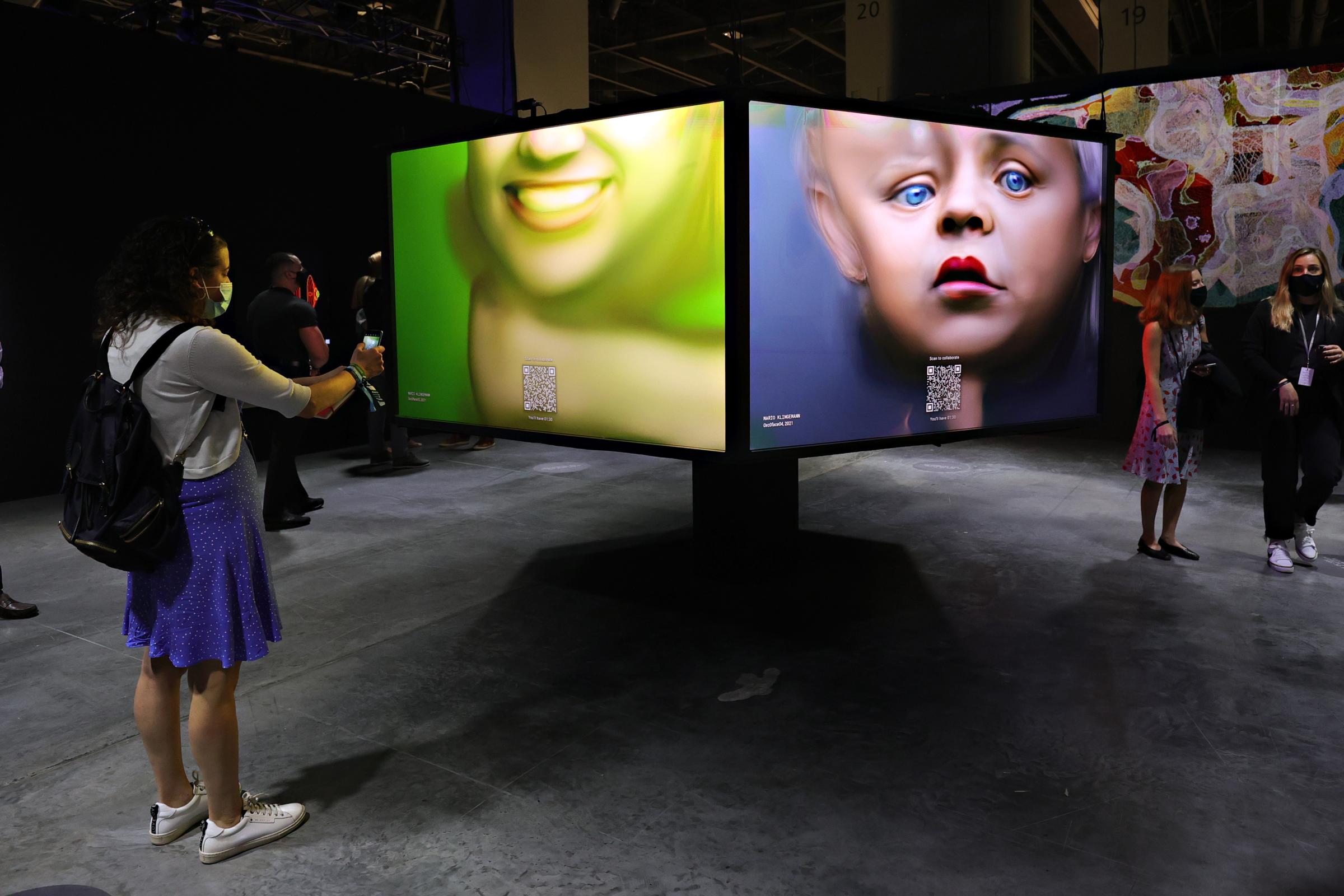
Behind the high white walls of a nondescript single-story building in Miami’s Wynwood neighborhood, past the velvet ropes and ticket-checkers, and through a hallway filled with disorienting billows of white smoke lies Aku World, the alternate universe of Aku, a young Black astronaut. The blank walls of one room were covered with moving projections of this cartoon extraterrestrial universe. At the center, a giant space helmet you could walk inside to view videos. In other rooms: traditional art from the likes of Jean-Michel Basquiat and young artists Jade Yasmeen and Floyd Strickland; a “merch” room with virtual 3D displays of branded backpacks and hoodies; and a futuristic sanctum with a massive, ovoid version of a TSA body scanner, used for 4D body-mapping. Visitors could develop and “mint” their own personalized avatars for the Aku World metaverse. A line of patrons snaked out the hallway.
One of those people on this balmy Thursday evening of Art Basel Miami was Cooper Turley. Wearing designer sneakers, a black turtleneck and a diamond chain, Turley towered over his fellow Aku fans in line, a collection of diverse young people who had managed to snag one of the exclusive tickets to the pop-up. “I’ve been following the story for six months at this point,” Turley says proudly.
But Turley, 26, was more than just another Aku fan. An investor in the project, Turley is also an NFT collector and a Twitter personality known for sharing upbeat takes on the future of the emerging world of web3. Originally an avid Pokemon collector—the type of teen who spent hours searching out rare cards on eBay—Turley turned a college music business degree into a career as an angel investor and general crypto expert after becoming intrigued by the concept of so-called “smart” contracts for music, which could more effectively apportion out revenue to the many stakeholders involved in a track.
These days, he holds somewhere around 400 to 500 unique NFTs, ranging from an original Crypto Kitty (his first-ever NFT purchase) to a one-of-one from Fvckrender that he bought for a hefty 10ETH (currently about $44,000). “If I were trying to get [my collection] appraised today? It would be, like, a couple million dollars,” he says, doing some quick mental math.
How NFT art collecting works
Just like there are famous physical world art collectors—Peggy Guggenheim, J. Paul Getty, the Broads—Turley has joined the ranks of high-end NFT art collectors, as non-fungible tokens became the talk of the crypto and art worlds this year. (NFT auction platform OpenSea has tracked over $10 billion worth of sales since it launched in 2017. The buzz peaked last spring with the much-ballyhooed $69 million auction price for a one-of-one Beeple art work.) While an NFT can be anything, the first and most visible use-case so far has been for digital art. Sometimes that means a moving image. Or an audio-visual clip. Or a “profile picture project” (PFP) like CryptoPunks or Bored Ape Yacht Club, drawings that are variations on a theme within a particular universe. (Aku World started out as a collection of Aku NFTs.) Or a physical sculpture with an NFT certificate of ownership. More and more, it also can mean tokens that provide access to exclusive events or content—also a perk, in this instance, of Aku NFT ownership.
Read More: Teen Artists Are Making Millions on NFTs. How Are They Doing It?
For Turley, being a collector (and investor and advisor) in this space is both a career and, it seems, a calling. His social and professional lives are deeply intertwined. In Miami, his days were a mix of attending events like Aku World and carrying on into near-dawn club adventures with fellow collectors and artists he’s befriended. “There’s one part of my collecting that’s all about patronage,” he says. “It’s my friends getting involved in the space, so I am buying their work to simply say thank you for believing in this, thank you for taking a chance and putting your art into this ecosystem.”
The other part is speculation. “There’s a science to knowing which entities are going to go up and being able to flip those,” he says. After all, he’s been able to build a multimillion dollar collection off his early crypto investments and willingness to play that game.
The value of community
Turley’s approach—recognizing both the power of patronage and the potential of speculation—is one echoed by most collectors in these early, volatile days of the NFT market. Jake Roberts, 38, also found his professional sweet spot as a collector and speculator. Crypto—and NFT art collecting—changed his life; after going through a divorce and diving into crypto self-education via the audio hangout app Clubhouse during the pandemic, Roberts left his role as the program director of a homeless shelter in Atlanta. He’s now a full-time NFT investor based in Miami. (He’s also building out a local cafe for “cannabis, coffee, crypto and tacos,” he says happily.) But you wouldn’t know any of this from his unassuming appearance; he shows up at a low-key pool party on a residential street in downtown Miami in a faded tank top, shorts, and a Patagonia baseball cap covering his grey hair, swigging from a bottle of electric yellow Gatorade.
Roberts is here to say hello to the Queens-based music artist and general hype man Artz (real name: Raymond Allende), founder of the artist collective Reject Dreams. Roberts invested in some of Artz’s audio-visual works (and NFTs), and they’re friends via Clubhouse. With boyish energy, he settles onto a couch by a dusty pool table to explain his philosophy of NFT investing. Roberts has 487 works when we talk, and wants to hit 500 by the end of the weekend, with a budget to burn of roughly $200,000.
He had been dabbling in crypto since 2017, but made his first NFT purchase in spring 2020, with a reasonably-priced piece from “some brothers in Russia,” he remembers, who he discovered on Clubhouse. “I got in for the community. And then—” he pauses. After he had collected about 100 works he loved, including four Bored Apes, three of which he sold for a healthy profit, “then I got in for the money.”
More from TIME
Read More: NFTs Are Shaking Up the Art World—But They Could Change So Much More
Now he’s using what he calls “house money,” re-investing his wins. “The reality is, it’s insider trading,” he says wryly. But with a cause: he likes to support early-stage artists who need the money to live. That positive feedback loop, and the sense that he’s making a difference in someone’s life, “is like a drug.” “I came from the world of understanding my privilege and helping people that have nothing,” he says. He has a system now for deciding what’s a worthy project, based on the rarity of the pieces, his trust in the people behind the project, and whether it’s a safe bet or a risky one.
Roberts knows it might look like he’s having a midlife crisis right now. But he says he’s never felt a stronger sense of purpose: to invest in the future, and be a part of supporting the paths of artists he believes in—like Artz—who wouldn’t otherwise get a chance. We say goodbye, and he jumps up, snaps a quick selfie with Artz, and heads out to the next art exhibition.
“I didn’t even know what the guy looked like until a few weeks ago,” Artz says after Roberts leaves. But his early support has been meaningful in helping Artz raise his profile. Later in the weekend, Artz would perform with rapper Busta Rhymes.
Is NFT art “real art”?
To outsiders, the NFT art world can look like a joke, or a bunch of high rollers playing a computer game. For those inside it, it is a game—but one with real stakes. Nowhere was that more clear than at the nft now x Christie’s party in downtown Miami, hosted in a corporate venue transformed into an NFT art gallery and party spot. On the blacked-out walls, digital works by top-selling artists like Fvckrender, Chad Knight and Dave Krugman popped out of the darkness. The open bar seemed of less interest to most than the works themselves.

Turley circulated with other bigwigs in the scene: collectors like Kamiar Maleki, director of Volta Art Fairs and Colborn Bell, the tall, bearded head of the Museum of Crypto Art; artists and celebrities like Beeple, Fewocious, Jared Leto and Timbaland. The Christie’s co-sign gave this new generation an air of officiality. But at the main Art Basel fair in a cavernous event space on Miami Beach, Turley felt out of place; he admits he’s not a traditional art connoisseur. Most of the booths were hosted by galleries—and NFT artists tend to bypass gallery representation. (One booth by blockchain company Tezos was a hit, however, and 5,000 NFTs were minted there over the course of the week.)
“I felt a little bit of a disconnect,” Turley says. “All the art on display was physically appealing, and it looked fantastic,” but he didn’t feel the sense of connection that he could find with NFTs. “One of the things that I like the most about NFTs is that you are not bidding on the art itself, you’re bidding on a relationship with the creator. We are in an early enough stage where that could happen. The reason that a lot of people are spending so much money on NFTs is because they really want to get connected to that artist on a personal level,” he says. Turley himself has advised artists and creators on their NFT entrances.
Crypto winter is coming
Of course, in an emerging, unregulated market, not all plays are wins. Collectors spoke blithely about getting “rugged” on certain NFT investments, about how easy it is for hackers to entice potential investors into fake projects, into scams that result in an empty crypto wallet before they can back out of the exchange. But more often than not, a loss just sparks the desire to try again; risk is the accepted name of the game.
Back at Aku World, Turley was joined by artist Isabella Addison and fellow young collector Brett Shear. (Shear focuses on music NFT collecting.) After Turley minted his new Aku avatar, the trio—already tired after a few days of the Miami party circuit—grabbed dinner at a low-key gyro restaurant a few blocks away, then headed to an event hosted by digital music collective Poolsuite. For artists like Addison, the support of these collectors has helped buoy her to stardom. On Saturday night, she was out and about with a collector who goes by the name Seedphrase, who recently estimated his NFT collection’s value at around $12 million. At a party co-hosted by Playboy and Proof of Party, a web3-focused event series, the walls flashed with moving projections of models. Pop star Charli XCX was in the deejay booth. A few hours later, Addison would wake up to hand-paint a Bentley for an auction. She was moving into a new apartment in L.A. soon.
The collectors all warned of an upcoming “crypto winter” of increased volatility, for which they’re preparing by diversifying their investments into things like metaverse properties and crypto-focused DAOs (decentralized autonomous organizations that invest as a collective). But for artists like Addison who are already reaping the rewards of their patronage, the season ahead looks bright.
More Must-Reads from TIME
- Why Biden Dropped Out
- Ukraine’s Plan to Survive Trump
- The Rise of a New Kind of Parenting Guru
- The Chaos and Commotion of the RNC in Photos
- Why We All Have a Stake in Twisters’ Success
- 8 Eating Habits That Actually Improve Your Sleep
- Welcome to the Noah Lyles Olympics
- Get Our Paris Olympics Newsletter in Your Inbox
Write to Raisa Bruner at raisa.bruner@time.com